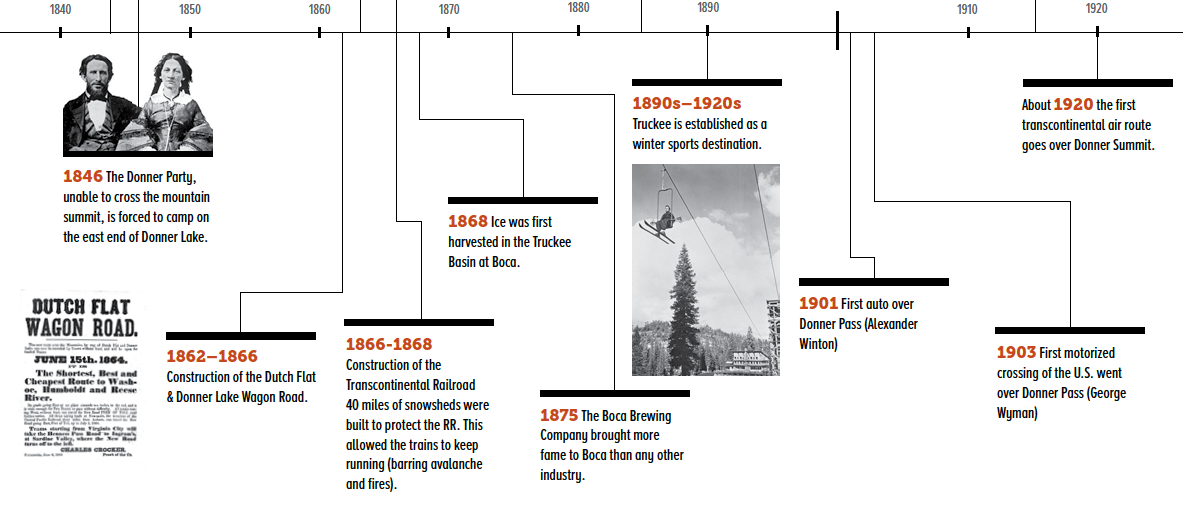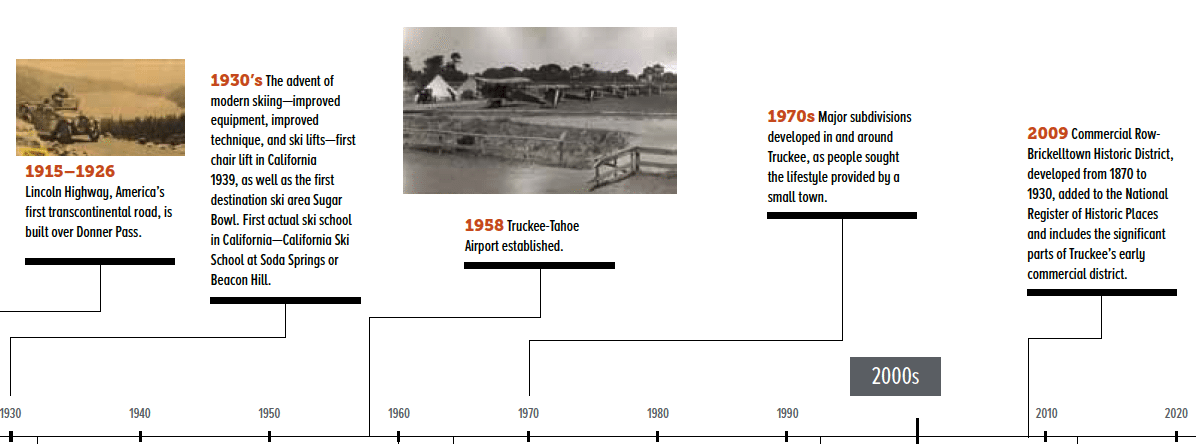History
#MICRONET_HEADING#
1844 How ‘Truckee’ Got Its Name & Stephens Party
A friendly Paiute Indian chief assisted thousands of emigrants in their migration west across the Humboldt Sink through forty mile desert. The Indian’s name sounded like ‘Tro-kay’ to the white men, who dubbed him ‘Truckee.’ Guided by mountain man Caleb Greenwood the Stephens-Townsend-Murphy Party (sometimes called just the Stephens Party) became the first Emigrant wagon train that successfully crossed the Sierra. Elisha Stephens called the small lake beneath the pass Mountain Lake.
1846 Donner Party
The Donner Party followed the Truckee Route to the California Trail, a branch of the Emigrant Trail, to attempt a crossing what is now called Donner Pass. Arriving in late October, heavy snows had already begun creating harsh conditions for their journey. The party was said to have resorted to cannibalism to survive the winter. 47 of the 87 men, women and children perished. More can be learned of their fascinating story at Donner Memorial State Park where you can visit the museum and Pioneer Monument.
1846-1848 Emigrant Trail
In this short period, thousands of emigrants passed westward through the Truckee Basin on the Truckee Route of the California Trail. It ran through Stampede and Prosser Valleys, past Truckee into the Coldstream Valley, and over the Sierra crest via Roller Pass, where wagons were hauled up the steep slope using chains. After 1849 emigrants used other, easier, routes to travel into the gold country of California.
1866 First Lumber Mill
Joseph Gray and George Schaffer built and operated the first lumber mill. Quickly, many other sawmills were built to supply the demand for wood products for the Central Pacific Railroad and Virginia City mines. Structural lumber, railroad ties, poles, fence posts, shingles, mine timbers, charcoal and firewood were cut from the extensive forest and shipped all over the West. The lumber industry was Truckee’s biggest business for decades.
1867 Railroad Construction
In spite of severe winter storms, San Mateo – a 40-ton locomotive – was hauled in pieces on sleighs by George Schaffer and assembled east of the site of today’s downtown. It was the first excursion train to near the summit. Up to 12,000 workers, including 10,000 Chinese worked on grading roadbed, blasting tunnels, and laying tracks over the Sierra Nevada. It was the country’s greatest achievement of the 19th century.
1868 Coburn’s Station & Reno to Sacramento Rail Completion & Coburn’s Fire & Ice Harvesting
April 28, 1868 : the Nevada City Daily Transcript, announced “The name Coburns Station has been discarded by the people of that town and is now called ‘Truckee’.” / June 18, 1868 : The Virginia City Daily Trespass carried the announcement “…last evening we received a dispatch from Coburn’s stating that the last connecting rail between California and Nevada, on the Central Pacific Railroad, had been laid. Tomorrow the cars will run from Reno to Sacramento.” / July 30, 1868 : A fire broke out destroying all of Coburn’s Station, except Gray’s cabin and the lumber mills located south of the river. / Ice was first harvested in the Truckee Basin at Boca. By 1869, the Boca Mill & Ice Company had built an ice house with a capacity of 8,000 tons. Soon the area was crowded with other companies, all seeking a share of the profit. With the completion of the railroad, the ice could be used to refrigerate the fruits and vegetables produced in the great valleys of California for shipment across the country.
1871 Schaffer’s Mill & Truckee’s Fires
After Schaffer purchased Gray’s interest, Schaffer built a larger mill in Martis Valley, three miles south of Truckee. His mill supplied lumber to the mines of Virginia City and the growing cities of Sacramento and San Francisco. Three times in 1871 Truckee suffered major fires that burned most of the downtown district, each time the citizens quickly rebuilt.
1875 Tourism & Beer Brings Fame to Boca
The Boca Brewing Company was incorporated. Production of beer was an immediate success. From the time of construction until its destruction by fire in 1893, the Boca Brewing Company brought more fame to Boca than any other industry. The Truckee area was gaining fame as a tourist destination and summer resort area. Stagecoaches filled daily with passengers headed to Lake Tahoe, Independence Lake and Webber Lake among others.
1886 Chinese Boycott
After many years of racial tension, the white citizens of Truckee drove out the entire Chinese population (who had been instrumental in the building of the railroad) by forming a general boycott and refusing to buy or sell with Chinese residents. The Chinese contributed years of hard labor in the railroad, lumber, ice and other industries. Economic hard times led to a reduction of employment, which caused the citizens to boycott the Chinese.
1890-1920 Truckee’s Winter Carnivals
Truckee is established as a winter sports destination. An ice palace with walls three feet thick covered with chicken wire and hosed inside and out with water formed a shimmering palace of ice. For years tourists poured from excursion trains to enjoy the ice palace and Truckee’s winter sports. Tobogganers climbed a seventy-five foot tower above the roof, then slid whooping and shrieking one hundred and fifty feet to street level. These Winter Carnivals featured skiing, skating, sledding and dog races. The Carnivals attracted almost 2,000 annual visitors, over half of whom came from Sacramento.
1910-1940 Motion Picture Industry Moves In
Hollywood film companies were intrigued by the town’s mountain charm and began establishing it as a center for the budding motion picture industry. The first film was shot in 1910. Lasting into the early 1940’s, Truckee hosted stars such as Charlie Chaplin, Clark Gable, Tom Mix, Mary Pickford, George Bancroft, Buster Keaton, Greta Garbo, Wallace Berry, John Barrymore, Will Rogers, John Wayne, and Henry Fonda. 82 movies were filmed here before 1941.
1915-1926 Lincoln Highway Built & US Highway 40 Dedication
In 1915 Lincoln Highway, America’s first transcontinental road, is built over Donner Pass. In 1926 U.S. Highway 40 (known as Lincoln Highway) Donner Summit Bridge dedication ceremony.
1927 Refrigerated Train Cars Destroy Ice Harvesting Business
Competition from refrigerated train cars gradually forced the closing of the ice ponds in the Truckee Basin. Truckee Lumber industry had also dwindled to one large sawmill at Hobart Mills.
1932-1940 ‘Snowball Special’ Excursion
The Southern Pacific Railroad established an excursion train called the ‘Snowball Special’. The train left San Francisco after midnight and returned the next midnight, giving excursionists most of the day in Truckee. The ‘Snowball Special’ ran until 1940 when the automobile and improved highways put it out of business.
1935 Motion Picture Association Formed
The Truckee Motion Picture Association was organized to maintain Hollywood’s interest in filming nearby and handled all business arrangements for movie/production companies operating out of Truckee.
1952 Snowstorms Maroon Streamliner
Snowstorms closed the highway for nearly a month. This same series of storms, the worst in a century, also marooned 226 passengers aboard the westbound ‘City of San Francisco’ streamliner. The train sat snowbound at Emigrant Gap for three days before rescuers reached it. Truckee played a major role in rescuing the passengers and reopening the railroad to train traffic.
1960 Squaw Valley Olympic Games
The Olympics descend on the Truckee area for the winter games at Squaw Valley, located 10 miles to the south of Truckee. The coverage of the games established the Truckee-Tahoe area as a major resort destination for year-round recreation.
1964 Interstate 80 Completed
Interstate 80’s path over the Sierra followed that of the transcontinental railroad and paralleled it in terms of immensely difficult construction. Five years were required to build only ten surfaced miles across the granite cliffs of Donner Pass. The freeway bypassed the difficult drive on the old High 40/Lincoln Highway and opened up the winter resorts to daily visitors.
1970 Major Subdivision Developed
Changing attitudes in the 1970s brought national attention to problems in urban areas. At this time, major subdivisions were developed in and around Truckee, as people sought the lifestyle provided by a small town. Truckee’s commercial district also benefited with increased tourism.
1993 The Town of Truckee Incorporated
After discussing and voting on self rule and incorporation for 120 years, the Town of Truckee incorporated in 1993. With the Truckee Fire District providing fire protection, that year, the District responded to 1,850 calls, including those for medical attention. Downtown Truckee continues to preserve and restore its historic character and was listed on the National Register of Historic Places in 2010.
Walking Map
Download the historic walking tour map PDF > to explore Truckee’s rich history at your own pace or go on a guided tour that tells fascinating stories, fables, and facts of railroad barons, lumber mills, ice harvesting, movie stars.




